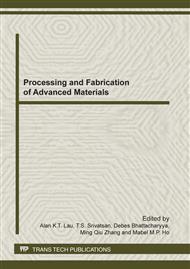p.59
p.63
p.67
p.71
p.75
p.79
p.81
p.86
p.90
Anti-Fungal and Anti-Algal Performances of Biocides Filled PVC and Wood/PVC Composites
Abstract:
The anti-fungal and anti-algal growth performances of wood poly (vinyl chloride) composite (WPVC) and poly (vinyl chloride) (PVC) containing either fungicides or algaecides at various concentrations were quantitatively evaluated using biological standard tests. The commercial fungicides, namely Carbendazim and IPBC in range of 10,000-50,000 ppm, and algaecides, namely Terbutryn and Isoproturon in range of 250-1,500 ppm, were incorporated into PVC and PVC composites with a fixed wood flour content of 100 pph. Disk diffusion test and dry weight technique, using Aspergillus niger as testing fungi, were used for anti-fungal evaluation while inhibition zone test using Chlorella vulgaris as testing algae, were utilized for anti-algal evaluation. The results suggested that IPBC exhibited better anti-fungal efficiency than Carbendazim for both PVC and WPVC composites, especially at the suggested IPBC concentrations of 30,000 ppm or higher. Terbutryn showed better anti-algal efficiency than Isoproturon. The recommended loadings of Terbutryn for complete algae killing were 1,000 and 500 ppm for neat PVC and WPVC composites, respectively. The wood particles added in PVC were found to improve the anti-fungal and anti-algal properties in PVC composites, which could be regarded as “anti-microbial promoter” under the commercial biocides used in this work.
Info:
Periodical:
Pages:
75-78
Citation:
Online since:
November 2011
Authors:
Price:
Сopyright:
© 2012 Trans Tech Publications Ltd. All Rights Reserved
Share:
Citation:


